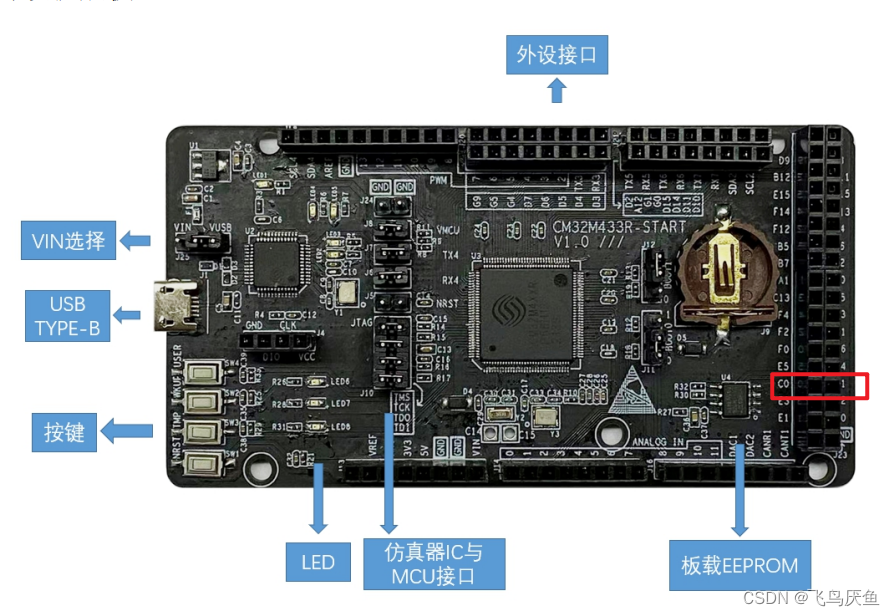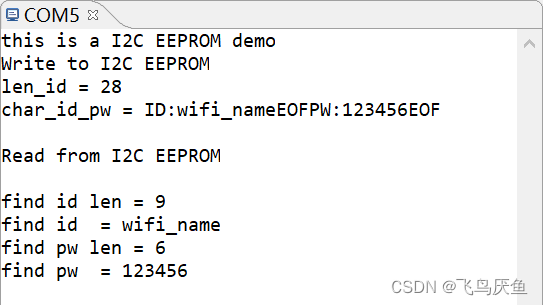1 前言
本章介绍下使用芯昇的eeprom保存wifi账户和密码。
测试功能块:I2C
2 硬件
如图,eeprom使用的是PC0和PC1。


3 打开示例
File – New – Project – Next – 选start下的

建议查看下readme.txt
代码
main.c
#include "nuclei_sdk_soc.h"
#include "i2c_eeprom.h"
#include "bsp.h"
#include "main.h"
// add .h
#include "string.h"
#include "stdlib.h"
uint8_t tx_buf[TEST_EEPROM_SIZE] = {0};
uint8_t rx_buf[TEST_EEPROM_SIZE] = {0};
volatile Status test_status = FAILED;
#define HEAD_ID "ID:"
#define HEAD_PW "PW:"
#define END_EOF "EOF"
#define WIFI_ID "wifi_name"
#define WIFI_PW "123456"
Status Buffercmp(uint8_t* pBuffer1, uint8_t* pBuffer2, uint16_t BufferLength);
void get_id();
void get_pw();
int main(void)
{
uint16_t i = 0;
log_init();
log_info("this is a I2C EEPROM demo\r\n");
/* Initialize the I2C EEPROM driver ----------------------------------------*/
I2C_EE_Init();
/* Fill the buffer to send */
for (i = 0; i < TEST_EEPROM_SIZE; i++)
{
tx_buf[i] = 0;
// log_info("tx_buf[%d]= %d\n",i,tx_buf[i]);
}
log_info("Write to I2C EEPROM\r\n");
/* First write in the memory followed by a read of the written data --------*/
/* Write to I2C EEPROM from TEST_EEPROM_ADDR */
// I2C_EE_WriteBuffer(tx_buf, TEST_EEPROM_ADDR, TEST_EEPROM_SIZE);
e2_set_wifi(WIFI_ID,WIFI_PW);
log_info("\nRead from I2C EEPROM\r\n");
/* Read from I2C EEPROM from sEE_READ_ADDRESS1 */
I2C_EE_ReadBuffer(rx_buf, TEST_EEPROM_ADDR, TEST_EEPROM_SIZE);
// print rx value ---- eeprom value
// print_eeprom();
get_id();
while (1)
{
}
}
void get_id()
{
char * temp_id_start;
char * temp_id_eof;
temp_id_start = strstr(rx_buf,HEAD_ID);
if(temp_id_start == NULL)
log_info("not find id\n");
else
{
// printf("find id = %s\n",temp_id_start+strlen(HEAD_ID));
temp_id_eof = strstr(rx_buf,END_EOF);
if(temp_id_eof == NULL)
log_info("not find pw eof\n");
else
{
temp_id_start = temp_id_start + strlen(HEAD_ID);
int len_id = temp_id_eof - temp_id_start ;
printf("\nfind id len = %d\n",len_id);
char * temp_id_value = (char *) malloc(len_id +1);
memset(temp_id_value,0x00,len_id+1);
strncpy(temp_id_value,temp_id_start ,len_id);
printf("find id = %s\n",temp_id_value);
// get pw
get_pw(temp_id_eof + strlen(END_EOF));
free(temp_id_value);
}
}
return;
}
void get_pw(char * str)
{
char * temp_pw_start;
char * temp_pw_eof;
temp_pw_start = strstr(str,HEAD_PW);
if(temp_pw_start == NULL)
log_info("not find pw\n");
else
{
// printf("find pw = %s\n",temp_pw_start+strlen(HEAD_PW));
temp_pw_eof = strstr(str,END_EOF);
if(temp_pw_eof == NULL)
log_info("not find pw eof\n");
else
{
temp_pw_start = temp_pw_start + strlen(HEAD_PW);
int len_pw = temp_pw_eof - temp_pw_start ;
printf("find pw len = %d\n",len_pw);
char * temp_pw_value = (char *) malloc(len_pw +1);
memset(temp_pw_value,0x00,len_pw+1);
strncpy(temp_pw_value,temp_pw_start ,len_pw);
printf("find pw = %s\n",temp_pw_value);
free(temp_pw_value);
}
}
return;
}
void print_eeprom()
{
for (int i = 0; i < TEST_EEPROM_SIZE; i++)
{
log_info("tx_buf[%d]= %02x\n",i,rx_buf[i]);
}
log_info("\n");
}
void e2_set_wifi(char* id, char* pw)
{
char* char_id_pw;
int len_id = strlen(id);
int len_pw = strlen(pw);
int len_all = len_id + len_pw + strlen(HEAD_ID) + strlen(HEAD_PW) + 2*strlen(END_EOF)+1;
log_info("len_id = %d\n",len_all);
char_id_pw =(char*)malloc(len_all);
memset(char_id_pw,0x00,len_all);
strcat(char_id_pw,HEAD_ID);
strcat(char_id_pw,id);
strcat(char_id_pw,END_EOF);
strcat(char_id_pw,HEAD_PW);
strcat(char_id_pw,pw);
strcat(char_id_pw,END_EOF);
log_info("char_id_pw = %s\n",char_id_pw);
I2C_EE_WriteBuffer(char_id_pw, TEST_EEPROM_ADDR, len_all);
free(char_id_pw);
return;
}
Status Buffercmp(uint8_t* pBuffer, uint8_t* pBuffer1, uint16_t BufferLength)
{
while (BufferLength--)
{
if (*pBuffer != *pBuffer1)
{
return FAILED;
}
pBuffer++;
pBuffer1++;
}
return PASSED;
}
1、功能说明
此例程展示了通过I2C模块与外部EEPRON的通信,分别采用查询、中断、DMA方式进行EEPROM的读写。
2、使用环境
/* 软件开发环境:当前工程使用的软件工具名称及版本号 */
IDE工具:NucleiStudio IDE for C/C++ 2022-01
/* 开发板 */
CM32M433R-START
3、使用说明
1、时钟源:HSE+PLL
2、主时钟:144MHz
3、I2C3 配置:
SCL --> PC0
SDA --> PC1
ADDR:0xA0(7bit)
CLOCK:400KHz
4、USART1配置:
TX --> PD0
波特率:115200
数据位:8bit
停止位:1bit
无校验
5、测试步骤与现象
a,将六类接口功能扩展板和CM32M433R-START进行连接
b,编译下载代码复位运行
c,从串口看打印信息,验证结果
d,修改i2c_eeprom.h中的PROCESS_MODE宏值,0代表查询方式进行I2C通信,1代表中断方式进行I2C通信,2代表DMA方式进行I2C通信。
e,重新编译下载代码,复位运行查看结果。
4、注意事项
1,此处使用的EEPROM是AT24C02,32个page,每个page 8byte
2,读写数据时若长度大于一个page,则器件地址会自动回卷
3,SCL,SDA有1K的外部上拉电阻
log

至此成功将wifi账户和密码存入eeprom。
可以测试将e2_set_wifi注销掉,然后打开print_eeprom(),验证下掉电是否保留。






















 2487
2487











 被折叠的 条评论
为什么被折叠?
被折叠的 条评论
为什么被折叠?








